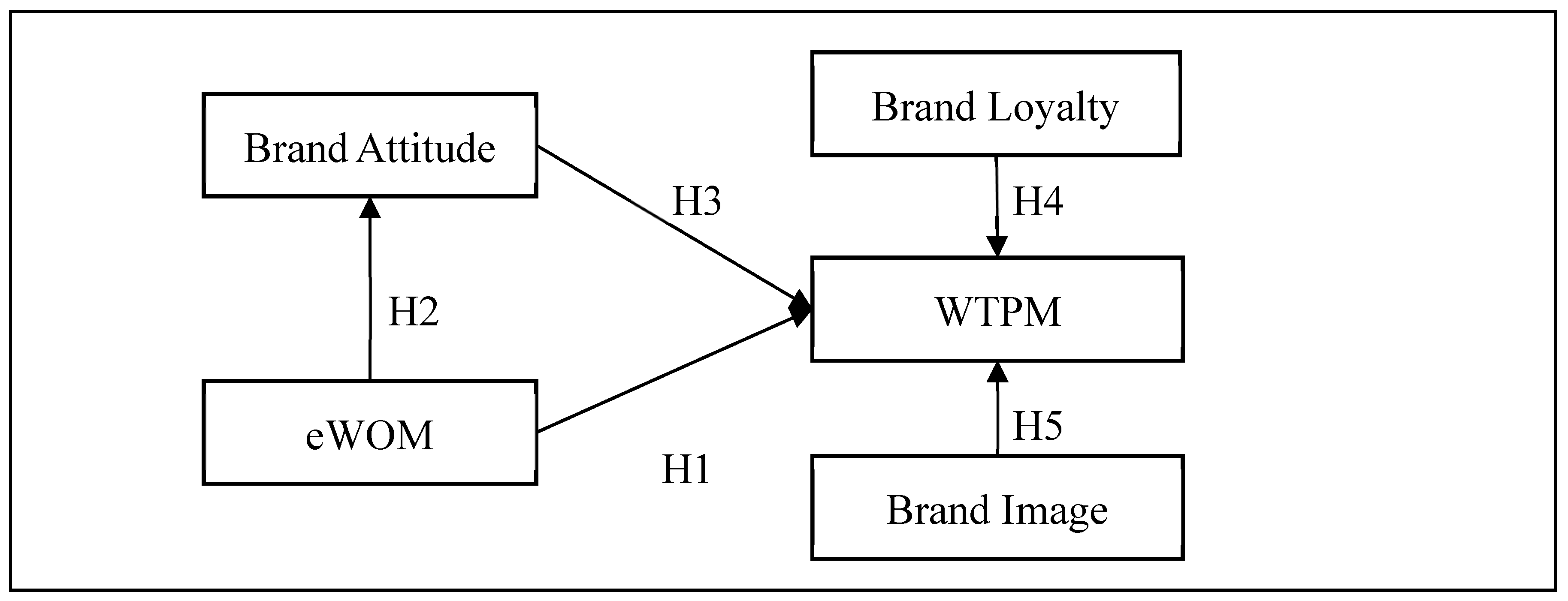Conceptualizing eWOM, Brand Image, and Brand Attitude on Consumer’s Willingness to Pay in the Low-Cost Airline Industry in Thailand †
Abstract
:1. Introduction
2. Literature Review
3. Conceptual Model and Hypotheses
4. Research Methodology
5. Limitation and Contribution of This Research
References
- Javalgi, R.; Cutler, B.; Winans, W. At your service! Does country of origin research apply to services? J. Serv. Mark. 2001, 15, 565–582. [Google Scholar] [CrossRef]
- Nadarajana, G.; Bojeia, J.; Khalid, H. The study on negative eWOM and its relationship to consumer’s intention to switch Mobile Service Provider. Procedia Comput. Sci. 2017, 124, 388–396. [Google Scholar] [CrossRef]
- Henning-Thurau, T.; Gwinner, K.P.; Walsh, G.; Gremler, D.D. Electronic word-of-mouth via consumer opinion platforms: What motivates consumers to articulate themselves on the Internet? J. Interact. Mark. 2004, 18, 38–52. [Google Scholar] [CrossRef]
- Dobni, D.; Zinkhan, G.M. In Search of Brand Image: A Foundation Analysis. In NA—Advances in Consumer Research Volume 17; Goldberg, M.E., Gorn, G., Pollay, R.W., Eds.; Association for Consumer Research: Provo, UT, USA, 1990; pp. 110–119. [Google Scholar]
- Low, G.S. and Lamb, C.W. The measurement and dimensionality of brand associations. J. Prod. Brand Manag. 2000, 9, 350–362. [Google Scholar] [CrossRef]
- Anwar, A.; Gulzar, A.; Sohail, F.B.; Akram, S.N. Impact of Brand Image, Trust and affect on consumer brand extension attitude: The mediating role of brand loyalty. Int. J. Econ. Manag. Sci. 2011, 1, 73–79. [Google Scholar]
- Arif, M. The influence of electronic word of mouth (eWOM), brand image, and price on re-purchase intention of airline customers. J. Appl. Manag. 2019, 17, 345–356. [Google Scholar] [CrossRef]
- Augustoa, M.; Torres, P. Effects of brand attitude and eWOM on consumers’ willingness to pay in the banking industry: Mediating role of consumer-brand identification and brand equity. J. Retail. Consum. Serv. 2018, 42, 1–10. [Google Scholar] [CrossRef]
- Kempf, D.S.; Smith, R.E. Consumer processing of product trial and the influence of prior advertising: a structural modeling approach. J. Mark. Res. 1998, 35, 325–338. [Google Scholar] [CrossRef]
- Krystallis, A.; Chrysochou, P. The effects of service brand dimensions on brand loyalty. J. Retail. Consum. Serv. 2014, 21, 139–147. [Google Scholar] [CrossRef]
- Wang, S.; Kao, G.; Ngamsiriudom, W. Consumers’ attitude of endorser credibility, brand and intention with respect to celebrity endorsement of the airline sector. J. Air Transp. Manag. 2017, 60, 10–17. [Google Scholar] [CrossRef]
- Oliver, R.L. Satisfaction: A Behavioral Perspective on the Consumer; McGraw-Hill: New York, NY, USA, 1997. [Google Scholar]
- Yoo, B.; Donthu, N. Developing and validating a multidimensional consumer-based brand equity scale. J. Bus. Res. 2001, 52, 1–14. [Google Scholar] [CrossRef]
- Aaker, D.A. Managing Brand Equity: Capitalizing on the Value of a Brand Name; The Free Press: New York, NY, USA, 1991. [Google Scholar]
- Jiang, H.; Zhang, Y. An investigation of service quality, customer satisfaction and loyalty in China’s airline market. J. Air Transp. Manag. 2016, 57, 80–88. [Google Scholar] [CrossRef]
- Caruana, A. Service loyalty: The effects of service quality and the mediating role of customer satisfaction. Eur. J. Mark. 2002, 36, 811–828. [Google Scholar] [CrossRef]
- Krystallis, A.; Chrysochou, P. The effects of service brand dimensions on brand loyalty. J. Retail. Consum. Serv. 2014, 21, 139–147. [Google Scholar] [CrossRef]
- Netemeyer, R.G.; Krishnan, B.; Pullig, C.; Wang, G.; Yagci, M.; Dean, D.; Ricks, J.; Wirth, F. Developing and validating measures of facets of customer-based brand equity. J. Bus. Res. 2004, 57, 209–224. [Google Scholar] [CrossRef]
- Ayadi, N.; Lapeyre, A. Consumer purchase intentions for green products: Mediating role of WTP and moderating effects of framing. J. Mark. Commun. 2014, 22, 367–384. [Google Scholar] [CrossRef]
- Toklu, I.; Kucuk, H. The impact of brand crisis on consumers green purchase intention and willingness to pay more. Int. Bus. Res. 2017, 10, 22–33. [Google Scholar] [CrossRef]
- Ong, C.; Lee, H.; Ramayah, T. Impact of brand experience on loyalty. J. Hosp. Mark. Manag. 2018. [Google Scholar] [CrossRef]
- Kudeshia, C.; Kumar, A. Social eWOM: does it affect the brand attitude and purchase intention of brands? Manag. Res. Rev. 2017, 40, 310–330. [Google Scholar] [CrossRef]
- Davis, D.; Golicic, S.; Marquardt, A. Measuring brand equity for logistic services. Int. J. Logist. Manag. 2009, 20, 201–212. [Google Scholar] [CrossRef]

Disclaimer/Publisher’s Note: The statements, opinions and data contained in all publications are solely those of the individual author(s) and contributor(s) and not of MDPI and/or the editor(s). MDPI and/or the editor(s) disclaim responsibility for any injury to people or property resulting from any ideas, methods, instructions or products referred to in the content. |
© 2020 by the authors. Licensee MDPI, Basel, Switzerland. This article is an open access article distributed under the terms and conditions of the Creative Commons Attribution (CC BY) license (http://creativecommons.org/licenses/by/4.0/).
Share and Cite
Yodpram, S.; Intalar, N. Conceptualizing eWOM, Brand Image, and Brand Attitude on Consumer’s Willingness to Pay in the Low-Cost Airline Industry in Thailand. Proceedings 2019, 39, 27. https://doi.org/10.3390/proceedings2019039027
Yodpram S, Intalar N. Conceptualizing eWOM, Brand Image, and Brand Attitude on Consumer’s Willingness to Pay in the Low-Cost Airline Industry in Thailand. Proceedings. 2019; 39(1):27. https://doi.org/10.3390/proceedings2019039027
Chicago/Turabian StyleYodpram, Somcanae, and Nuchjarin Intalar. 2019. "Conceptualizing eWOM, Brand Image, and Brand Attitude on Consumer’s Willingness to Pay in the Low-Cost Airline Industry in Thailand" Proceedings 39, no. 1: 27. https://doi.org/10.3390/proceedings2019039027
APA StyleYodpram, S., & Intalar, N. (2019). Conceptualizing eWOM, Brand Image, and Brand Attitude on Consumer’s Willingness to Pay in the Low-Cost Airline Industry in Thailand. Proceedings, 39(1), 27. https://doi.org/10.3390/proceedings2019039027




